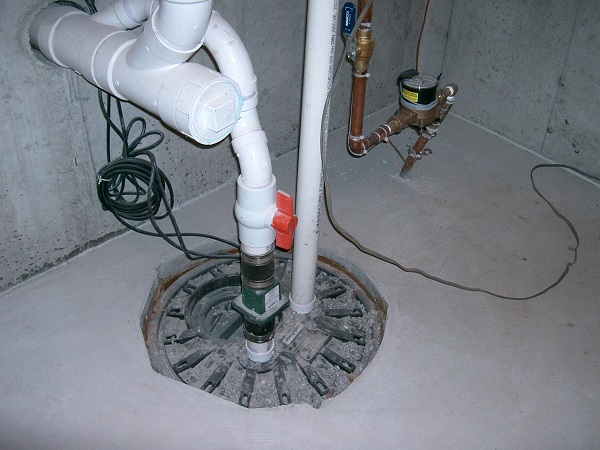Basements are a popular feature in many homes, offering additional living or storage space.
However, they are also prone to water-related issues, especially in areas with high water tables or frequent rainfall.
A sump pump is a crucial component in safeguarding basements against flooding and water damage. This in-depth guide covers everything you need to know about sump pumps, including their purpose, installation, maintenance, costs, and more.
What is a Sump Pump in a Basement For?
A sump pump is a device installed in the lowest part of a basement, typically in a sump pit, to prevent water accumulation.
Its primary purpose is to pump out water that collects in the pit, directing it away from the home’s foundation and into a designated drainage area.
Key Functions of a Sump Pump:
- Flood Prevention: Protects basements from flooding during heavy rains, melting snow, or rising groundwater.
- Foundation Protection: Reduces water pressure against the foundation to prevent cracks and instability.
- Mold and Mildew Control: Keeps the basement dry to limit mold and mildew growth.
- Property Value Maintenance: A dry basement adds value and appeal to a home.
How Does a Sump Pump Work?
A sump pump works by automatically detecting water levels in the sump pit and activating when needed. Here’s a step-by-step breakdown:
- Water Collection: Water from the ground or drainage systems flows into the sump pit.
- Activation: A float switch detects the rising water level. When it reaches a certain point, the pump activates.
- Water Removal: The pump uses a motor to push water through a discharge pipe and away from the home.
- Deactivation: Once the water level drops, the pump shuts off automatically.
Sump Pump Installation and Costs
Installing a sump pump requires careful planning to ensure efficiency and reliability. Here’s what you need to know:
Sump Pump Installation
- Location: The sump pit is typically placed in the lowest point of the basement.
- Drainage Plan: A professional ensures that the discharge line directs water far from the foundation.
- Pump Selection: Choose the right type (submersible or pedestal) and size based on the water volume and basement needs.
- Additional Features: Include a battery backup for power outages and an alarm system for warnings.
Sump Pump Installation Costs
The cost of sump pump installation varies depending on several factors, such as the type of pump and whether excavation is needed.
- Basic Installation: $500 to $1,200
- Advanced Systems (with backup or drainage improvements): $1,500 to $2,500+
- Sump Basin: Installing or replacing the sump pit or basin can add $100 to $400 to the overall cost.
Sump Pump Basin
The sump basin is a critical component of the system. It serves as the reservoir where water collects before being pumped out.
Features of a Good Sump Basin:
- Size: Typically 18 inches in diameter and 22 to 36 inches deep, depending on water volume needs.
- Material: Made from durable plastic or fiberglass to resist corrosion and cracking.
- Lid: A tightly sealed lid prevents debris from entering and minimizes noise.
Sump Pump Basement Repair
A malfunctioning sump pump can lead to severe flooding and water damage. Common repairs include:
- Float Switch Replacement: If the pump doesn’t activate, the switch may need replacement ($100–$200).
- Motor Repairs: Addressing motor issues or replacing the pump motor can cost $150–$500.
- Clogged Lines: Clearing discharge line blockages costs $75–$250.
- Sump Basin Repairs: Fixing a cracked or damaged basin can range from $200–$600.
Sump Pump Basement Flooding
Despite their effectiveness, sump pumps may fail, leading to flooding. Common reasons include:
- Power Outages: A backup system or generator is essential.
- Pump Overload: Heavy rains may exceed the pump’s capacity.
- Clogs or Freezing: Regular maintenance and insulated discharge pipes can prevent these issues.
- Improper Installation: Ensure professional installation to avoid misaligned components.
Should You Avoid a House with a Sump Pump?
While some buyers may hesitate to purchase a house with a sump pump, it doesn’t automatically mean trouble. Here’s what to consider:
- Pro: A sump pump indicates proactive measures against flooding.
- Con: It suggests the house may have water issues. Investigate the cause and ensure the pump is well-maintained.
- Pro Tip: Have a professional inspect the system and the home’s drainage setup before making a decision.
How Do You Maintain a Basement Sump Pump?
Regular maintenance is key to ensuring the sump pump’s longevity and reliability. Follow these tips:
- Inspect the Pump Quarterly: Check for visible damage, rust, or debris.
- Test the Pump: Pour water into the pit to ensure activation.
- Clean the System: Remove debris from the pit, inlet screen, and discharge pipe.
- Check the Discharge Line: Ensure it is clear and directs water far from the foundation.
- Service Annually: Hire a professional for a thorough inspection.
Conclusion
A sump pump is a vital tool for protecting your basement from water damage. While it has some drawbacks, proper installation, maintenance, and repairs can maximize its efficiency.
Whether you’re installing a new system or buying a house with an existing sump pump, understanding its role, costs, and upkeep will help you make informed decisions and keep your basement dry and safe for years to come.
Also Read
Troubleshooting common water pump problems: An in-depth guide for operators

